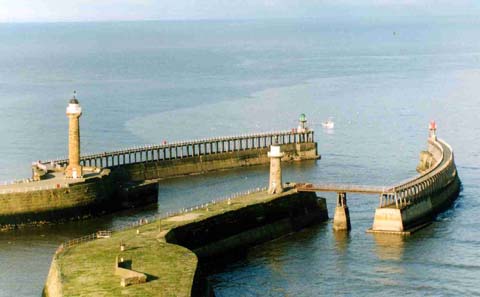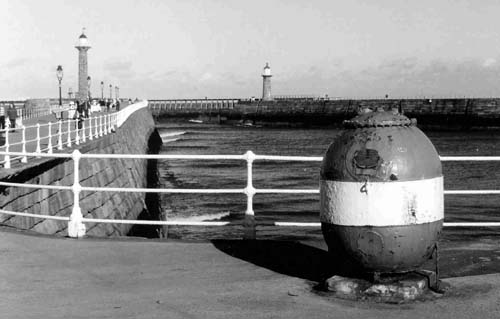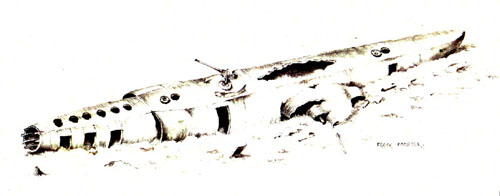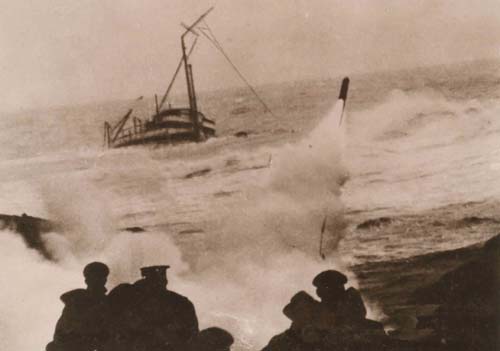
Dive Whitby
Whitby is a small fishing town situated on the Yorkshire coast well known for its Jet, a product used in jewellery but the area also boasts some very good diving wreck sites. During the summer months many visiting clubs are testament to the rich diving on offer. From all the wrecks on this part of the coast visiting clubs seem drawn to the wreck of the UC 70, a WWI German submarine and a hospital ship HM Rohilla, these two wrecks offer the diver the chance to dive something different, but these are merely two wrecks from the many listed on my wrecks page.

The UC 70
The German Government ordered their first submarine around 1906 and called it Unterseeboot Ein (Underseaboat One) or U.1. At the start of World War One Germany had only thirty eight uboat's in commission, submarines of this era were basically surface ships that could dive for brief periods. They could maintain a moderate speed whilst submerged yet for only a few hours before the batteries became exhausted, forcing them to return to the surface leaving them vulnerable to attack.
The UC70 was a VIIC type mine layer displacing 427 tons surfaced measuring 165 ft in length with a beam of 17ft, it was built in 1916 at the Blohm & Voss shipyard at Hamburg. The UC class of submarines were all minelayers, with the six mine laying chutes at the bows capable of holding three mines each. The submarine had an armament, which included an 88 - millimetre gun for use on the surface, two forward torpedo tubes, 1 aft torpedo tube and of course its mines. Throughout her two year service, the UC70 is believed to have sunk thirty three ships, totaling around 27,000 tons.
The submarine was sunk in June 1917 off Ostend but successfully raised and put back into service. Under the command of Oberlutnant Dobberstien the uboat left Zeebruge for the North East Coast. Conditions onboard the submarine would have deteriorated quickly as the fresh food went off, and the crews would soon revert to living on tinned food. Fresh water would have been limited for drinking, and washing was quite probably banned. With only one toilet for a crew of thirty, the stench of stale air, urine, unwashed bodies, diesel fumes and chlorine from the batteries would have made life onboard the sunken uboat quite sickening! The engines rattled and a need for frequent noisy running repairs would have made sleep almost impossible.
On August the 13th the UC70 was caught on the surface by a patrolling seaplane, which was following up the sighting of an oil slick assumed to be from the German submarine UB30 which had sunk two weeks earlier. Vary lights were dropped on the location of the submarine as it attempted to dive. This was followed by 520lb bomb from the plane, no doubt causing severe damage. The British destroyer HMS Ouse was soon on the scene and followed up the seaplane attack destroying the submarine using depth charges. The UC70 is recorded as having been responsible for the sinking of the Giraldo near Runswick Bay on the day of her own sinking.
Diving The UC70
The wreck of the UC 70 can be located approximately 3 miles up the coast from Whitby on a predominant rock seabed running parallel to the coast. Diving the UC70 can only be dived at Slack Water (two hours after high / low water at Whitby) as it lies in a area of strong tides.

The submarines mine laying tubes are perhaps the wrecks most notable feature and are generally easy to spot there are six of these impressive holes in a row, running vertically from the forward end of the boat. When released a mine would sink to the seabed and the lower cradle would anchor itself to the seabed. The mines were fitted with a soluble plug, which would dissolve allowing the mine to float up to the desired height on a set length of cable. This system was not without its faults and many submarines were lost if the soluble plug dissolved to quickly allowing the mine to rise underneath the submarine.
Just to the rear of the mine chutes there is an open hatch, a diver wearing streamlined equipment could possibly just about enter the submarine but I strongly warn anyone considering attempting to do so not to! There is very limited room within the hull of any submarine, let alone one that has been left to the mercy of the sea for so long, it is badly silted up making it dangerous to even attempt entering the wrecked uboat. Although the inner hull is largely intact the outer pressure hull is corroded away in many places. More importantly the wreck of the UC70 is classed as a War Grave and feelings run high in Whitby that the wreck should be treated with respect.
Behind the forward open hatch is the submarines gun, intact and pointing menacingly towards the surface as in a last act of defiance. When conditions allow it strikes a good photographic image, it is almost possible to imagine the devastating power the gun possessed. The conning tower once stood proud behind the gun until corrosion finally took its toll, it can now be found lying on the seabed on the port side. At the rear of the submarine the diver lies another open hatch also open as if to invite an unwary diver to enter. The UC 70 is an interesting dive and one, which can be dived quite comfortably in one dive without incurring heavy decompression penalties. The deck lies at around 22 metres depending on the tide with the seabed at 24 metres give or take the height of the tide. This makes it a good depth for club divers seeking something unique perhaps working towards deeper dives. The submarine is sitting almost upright with a small list to port, its long cylindrical shape helps divers navigate the wreck passing the wreck along one side before returning to the start point on the opposite side.
The following GPS marks should enable quick location of the wreck: 54 31 599 N / 000 40 131 W

The Rohilla
The Rohilla was built by Harland & Wolff, Belfast in 1906 for The British India Steam Navigation, designed as a passenger cruise liner, running frequently from England to India. The ship spent a number of years as a troopship, until she was requisitioned by the admiralty and converted for use as a hospital ship. David Landles Neilson, the captain of the Rohilla was born in Tranent, East Lothian in 1864. He had spent nearly forty of his fifty years at sea with the same company, The British India Steam Navigation and was given command of the ship as soon as she was built.
The ship was bound for Dunkirk on a route down the east coast a route the captain had not navigated before and had to contend with, German submarines, and mines scattered around the coastline many in un chartered minefields. The Whitby Coastguard was situated in the coastguard shelter on the cliffs, a position that would in good conditions give him an unparallel view of the coast. He was aware of the outline of the Rohilla, shocked, that the vessel before him appeared to be heading for 'Whitby Rock' a treacherous reef system, which would ultimately spell the end for the fine vessel. Under normal conditions the hazard would have been marked by the permanently moored Bell Buoy, but the war time restrictions meant that the bell had been silenced and the light extinguished. Despite signaling with a Morse lamp for thirty minutes the ship failed to alter course. A short while later there was a terrifying shudder as the ship hit the rocks mortally wounding it.

In an amazing feat Whitby's number two lifeboat the John Fielden was
rowed across the harbour, lifted over an eight-foot wall on the east
pier before finally being dragged across the scar. Even though the hull
of the lifeboat had been holed the lifeboat crew knew they had to act
at once. With its crew of fourteen it managed to rescue seventeen of
the ships crew. The second attempt succeeded in rescuing another eighteen
men. After making two successful rescue trips the lifeboat damage was
such that the lifeboat was not fit to launched again. The remaining
survivors were rescued by a motor lifeboat from Tynemouth that had to
endure a voyage in such poor weather. Of the 229 crew, doctors and nurses
originally on board only 145 survived.
Diving The Rohilla
Today the wreck lies in a line from Whitby Bell Buoy to Saltwick Nab with the bows pointing to shore. The inshore end of the wreck is in about 6 metres of water, whilst the seaward end is in around 16 metres deep. There are four complete boilers, with two pairs more or less in situ. The other boiler a donkey boiler sits upended. The ships shaft can be seen although the propellers have long since gone, as have the many exquisite portholes. Even weighing around 2½ tons and measuring 7ft long by 4ft wide the various owners of the wreck found enterprising ways of salvaging the propellers. One of the Rohilla's unique advantages is that she can be dived at almost any stage of the tide, tidal movement is small with the exception of spring tides. The shallow depths make it ideal for any club diver but many experienced divers choose it as an ideal off gassing dive. Due to the size of the wreckage it is scattered over a large area with much to see. The diver can see inside the boilers viewing the many pipes inside. Moving away from the boilers the diver will come across the double hull, is possible to see the many holes left from the missing portholes.
The motionless machinery parts lie astern around 25 metres away. Many of the salvaged parts can be seen in the old lifeboat station on the East Pier. The items include the treasured steering wheel. The lifeboat house has a vast collection of seafaring memorabilia and is well worth a visit. Throughout the dive season the wreck is often buoyed by local divers who ask that you respect the line, if you accidentally part the rope then they would appreciate it if you would re-tie the shot buoy in. Divers should be warned that the wreck is also owned by a local syndicate who regularly dive the wreck and prohibit any recovery of the wreck. The following GPS position for the Rohilla 54 29 977 N / 000 35 360 W will put you over the boilers. The UC70 and the Rohilla are just two of the many wrecks on offer to the visiting club diver. Accommodation is available to suit all tastes and pockets from campsites through bed and breakfast to hotels. Whitby harbour has a good concrete slipway suitable for all club dive boats, charges apply and these can be paid at the marina office. It has been a number of years since I had to give up diving and it is quite possible that the information presented above is outdated. If there is anything you feel could be amended, I would be happy to hear from you with an update.
© Copyright © Colin Brittain 1999 - 2022